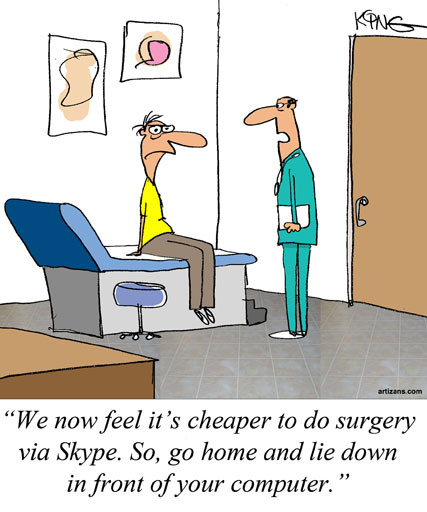Has Telehealth Gone Too Far, Too Fast?
Jerry King is the cartoonist for the Kaiser Family Foundation’s Kaiser Health News (which publishes a valuable daily briefing and is a great resource for healthcare news).
One of our issues at NCPA is digital health, especially telehealth (which we have researched since at least 2007). Things are finally moving in the right direction on telehealth adoption. King’s cartoon this morning made us wonder whether things are going too far, too quickly.
Original at Kaiser Health News.



There is a difference between being able to talk to a doctor on the phone, and having a doctor operate on you using his/her Gameboy Console. Robotic surgery is a reality. The DaVinci surgical robot can use used for a variety of surgeries. The robot has even been demonstrated by a surgeon who sat at a console in Paris and operated on a patient in North America. Most often, however, the surgeon is in the room or next room sitting at a control panel. There have been mixed reviews on robotic surgery. The consensus is that relatively inexperienced surgeons are using the technology when there is really no need for the costly machine. Maybe the key is to find which surgeries are candidates for a surgeon sitting in a central location performing surgeries remotely — rather than using a new $2 million dollar machine simply because it’s there.
I would hope that robotic surgery would lead to hyper-specialization among surgeons, so that each one could be the best at one very specific procedure with a patient with very specific problems.
We’ve often written about CVS MinuteClinics and other retail establishments. These are good for school physicals, sore throats, ear infections and other minor conditions. In addition, many conditions could be treated by a phone call with your doctor.
But I can imagine there being a market for telemedicine coupled with retail clinics. Rather than a nurse practitioner at the retail clinic, why not have a lessor-trained nurse coordinating with a doctor — possibly a specialist — who is on a video monitor via SKYP?
The stethoscope would be wired to the internet. A high definition camera could be wired. The nurse could handle the stethoscope, the HD camera, an perform the in-person interactions, such as drawing blood, swabbing the throat for a culture, etc. Rather than run room-to-room, the doctor could sit at a console. Sounds impersonal. But it could increase productivity and convenience. This could work especially well for chronic diseases. If someone has diabetes or hypertension, they could stop by for a consult. For that matter, diabetes education “group therapy” could be an effective and highly efficient way to treat patients. Of course, there are no mechanisms to pay for this. That means, each diabetic has to go individually to the doctor and miss out on the benefits of interacting with people with similar afflictions.
And also for catastrophic accidents and illness. The evidence base for telestroke surgery is pretty strong, I believe.
You cannot guarantee that if you have stroke, you will be near a stroke center of excellence. But if the community hospital is connected to an academic medical center with the best neurosurgeons, you will get great surgery to remove the clot.